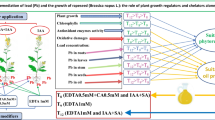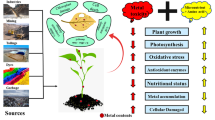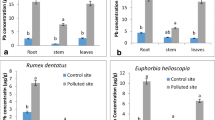Abstract
A study was conducted to determine the effect of ethylenediaminetetraacetic acid (EDTA) on phytoextraction potential of radish and cabbage. Plant biomass, photosynthetic pigments, proline and phenolics were significantly affected by the accumulation of heavy metals (HM). The metal uptake potential was increased significantly by the application of EDTA. Target hazard quotient (THQ) associated with exposure of these contaminants to food chain was calculated. Agronomic interventions to increase mineral levels in crops often increases the leaf concentrations only, the mineral concentration in edible portions are not increased at desired level due to low mobility of Zn in phloem. Since the leaves of both these crops are edible and a component of staple vegetarian diet, biofortification through Zn present in soil and its solubilization and mobilization through chelators can be implemented. However in no such instance these crops should be consumed when grown on Pb contaminated soil due to associated hazards.


Similar content being viewed by others
References
Bates L, Waldren RP, Teare ID (1973) Rapid determination of free proline for water-stress studies. Plant Soil 39:205–207
Bray HG, Thorpe WV (1954) Analysis of phenolic compounds of interest in metabolism. Methods Biochem Anal 1:27–52
Epstein AL, Gussman CD, Blaylock MJ, Yermiyahu U, Huang JW, Kapulnik Y, Orser CS (1999) EDTA and Pb–EDTA accumulation in Brassica juncea grown in Pb-amended soil. Plant Soil 208:87–94
Evangelou MHW, Nauer U, Ebel M, Schaeffer A (2007) The influence of EDDS and EDTA on the uptake of heavy metals of Cd and Cu from soil with tobacco Nicotianna tabacum. Chemosphere 68:345–353
Garba ST, Maina HM, Oseamehon SA, Barminas JT (2012) EDTA-assisted phytoremediation of heavy metal contaminated soil by Eleusine indica L. Gearth. J Environ Chem Ecotoxicol 4(5):103–109
Guala SD, Veg FA, Covelo EF (2010) The dynamics of heavy metals in plant-soil interactions. Ecol Modell 221:1148–1152
Hayat S, Hayat Q, Alyemeni MN, Wani AS, Pichtel J, Ahmad A (2012) Role of proline under changing environments A review. Plant Signal Behav 7(11):1456–1466
Huang G-Y, Wang Y-S (2010) Physiological and biochemical responses in the leaves of two mangrove plant seedlings (Kandelia candel and Bruguiera gymnorrhiza) exposed to multiple heavy metals. J Hazard Mater 182:848–854
Krämer U (2010) Metal hyperaccumulation in plants. Annu Rev Plant Biol 61:517–534
Kuzminov FI, Brown CM, Fadeev VV, Gorbunov MY (2013) Effects of metal toxicity on photosynthetic processes in coral symbionts, Symbiodinium spp. J Exp Mar Biol Ecol 446:216–227
Lichtenthaler HK (1987) Chlorophylls and carotenoids: pigments of photosynthetic biomembranes. Methods Enzymol 148:350–382
Lim JM, Salido AL, Butcher DJ (2004) Phytoremediation of lead using Indian mustard (Brassica juncea) with EDTA and electrodics. Microchem J 76:3–9
Luo C, Liu C, Wang Y, Liu X, Li F, Zhang G, Li X (2011) Heavy metal contamination in soils and vegetables near an e-waste processing site, south China. J Hazard Mater 186:481–490
National Institute of Nutrition (2011) Dietary guidelines for Indians: a manual. NIN, Hyderabad
Neilson S, Rajakaruna N (2012) Roles of rhizospheric processes and plant physiology in applied phytoremediation of contaminated soils using brassica oilseeds. In: Anjum NA, Ahmad I, Pereira ME, Duarte AC, Umar S, Khan NA (Eds) The plant family Brassicaceae. Springer, Dordrecht, Vol 21, pp 313–330
Prasad M, de Oliveira Freitas H (2003) Metal hyperaccumulation in plants—biodiversity prospecting for phytoremediation technology. Electron J Biotechnol 6(3):285–321
Schmidt R, Bancroft I (2010) Genetics and genomics of the Brassicaceae. Springer, Berlin
Shanmugam V, Lo JC, Wu CL, Wang SL, Lai CC, Connolly EL (2011) Differential expression and regulation of iron-regulated metal transporters in Arabidopsis halleri and Arabidopsis thaliana- the role in zinc tolerance. New Phytol 190(1):125–137
Sun Y, Zhou Q, An J, Liu W, Liu R (2009) Chelator-enhanced phytoextraction of heavy metals from contaminated soil irrigated by industrial wastewater with the hyperaccumulator plant (Sedum alfredii Hance). Geoderma 150:106–112
Szczygłowska M, Piekarska A, Konieczka P, Namiesnik J (2011) Use of Brassica plants in the phytoremediation and biofumigation processes. Int J Mol Sci 12:7760–7771
USEPA (2003) Integrated risk information system database (IRIS). USEPA, Washington
USEPA (2011) Exposure factors handbook 2011 edition (Final). USEPA, Washington
Venkatachalam P, Jayalakshmi N, Geetha N, Sahi SV, Sharma NC, Rene ER, Sarkar SK, Favas PJC (2017) Accumulation efficiency, genotoxicity and antioxidant defense mechanisms in medicinal plant Acalypha indica L. under lead stress. Chemosphere 171:544–553
White PJ, Broadley MR (2011) Physiological limits to zinc biofortification of edible crops. Frontiers Plant Sci. 2(80):1–11
Zaier H, Ghnaya T, Ben Rejeb K, Lakhdar A, Rejeb S, Jemal F (2010) Effects of EDTA on phytoextraction of heavy metals (Zn, Mn and Pb) from sludge-amended soil with Brassica napus. Bioresource Technol 101:3978–3983
Zhou H, Yang WT, Zhou X, Liu L, Gu JF, Wang WL, Zou JL, Tian T, Peng PQ, Liao BH (2016) Accumulation of heavy metals in vegetable species planted in contaminated soils and the health risk assessment. Int J Environ Res Public Health 13:289–300
Acknowledgements
Junior Research Fellowship to Ritu Chaturvedi (08/109(0011)/2013-EMR-I) by the Council of Scientific and Industrial Research is duly acknowledged. The support of Fundação para a Ciência e a Tecnologia, through the strategic Project UID/MAR/04292/2019 granted to MARE is gratefully acknowledged. We also thank University Grants Commission for granting Post Doctoral Fellowship (/PDFSS-2014-15-SC-UTT-8854) to Mayank Varun. We wish to acknowledge Dr. B.R. Ambedkar University, Agra for providing facilities.
Author information
Authors and Affiliations
Corresponding author
Rights and permissions
About this article
Cite this article
Chaturvedi, R., Favas, P., Pratas, J. et al. EDTA-Assisted Metal Uptake in Raphanus sativus L. and Brassica oleracea L.: Assessment of Toxicity and Food Safety. Bull Environ Contam Toxicol 103, 490–495 (2019). https://doi.org/10.1007/s00128-019-02651-9
Received:
Accepted:
Published:
Issue Date:
DOI: https://doi.org/10.1007/s00128-019-02651-9




